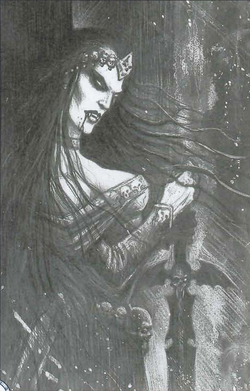
Lady Zmada's Portrait[2a]
Lady Zmada's Portrait is a famed painting of a female Vampire that possesses the magical property of being able to serve as a refuge for a Vampire during the daylight hours.
Vampires, unable to see themselves in mirrors yet often possessed of vanity beyond the conceit of mortals, sometimes become obsessed with their images. The great Tilean master painter Belardo was famously hired by the von Carsteins to paint portraits of them, for which he was justly rewarded - a mob burned him alive on top of a pyre made of his own works.[1a]
Lady Zmada's Portrait is another example of such work, a painting of a beautiful lady with an enigmatic expression. A Vampire may step through the empty frame of this portrait during the day and shelter there until dusk. During that time, the Vampire appears as an unmoving portrait of itself. If the painting is destroyed, the Vampire is slain.[1a]
History[]
The origin of the portrait is not known for sure, nor is the painter.[1a]
House Zmada was an aristocratic family of Vampires, claiming to be merchants from Ostland. When a wave of religious zeal swept the region, a group of Templar Witch Hunters led by one Lars Tonowe broke into their mansion. They found portraits of seven generations of the Zmadas hanging on the wall, and a larder fully stocked with food and wine. As they sat down to eat, the conversation turned to estimating the value of the exquisite paintings on the wall.[2a]
In the morning, the witch hunters' mob broke into the building to find the templars dead in their chairs. When one man noticed blood dripping from the mouths of the portraits, the mob fled the mansion. Shortly thereafter, they burned the building down.[2a] Somehow, one of the Zmada portraits survived. It then passed into a private collection, but its current whereabouts are unknown.[1a]
